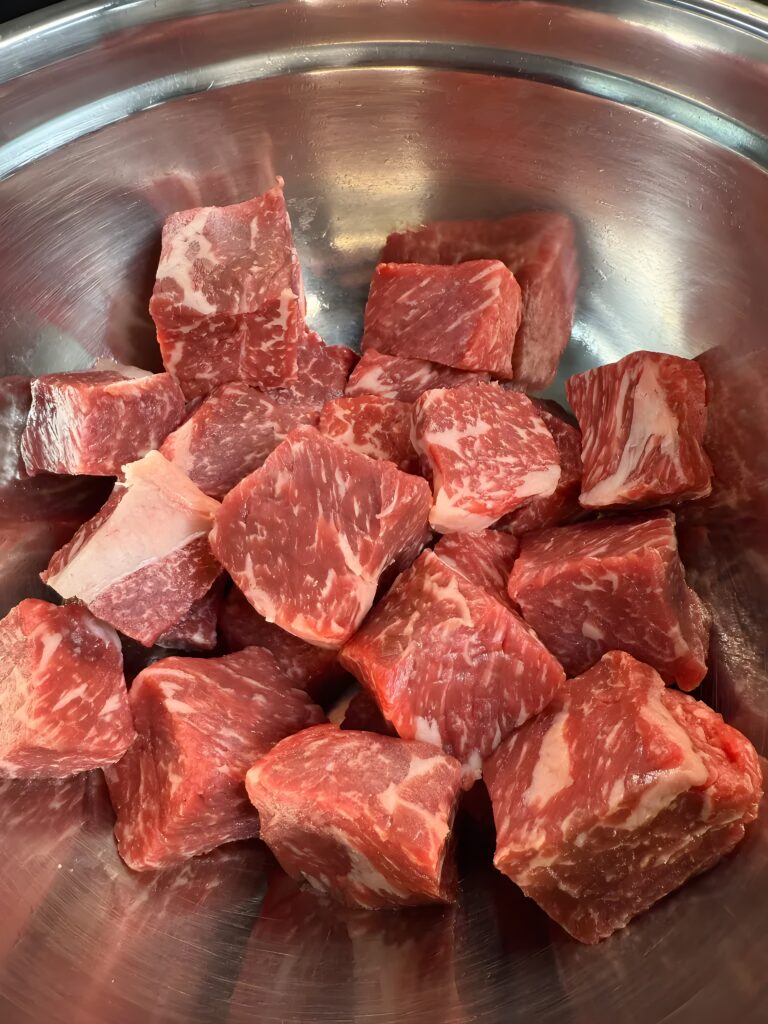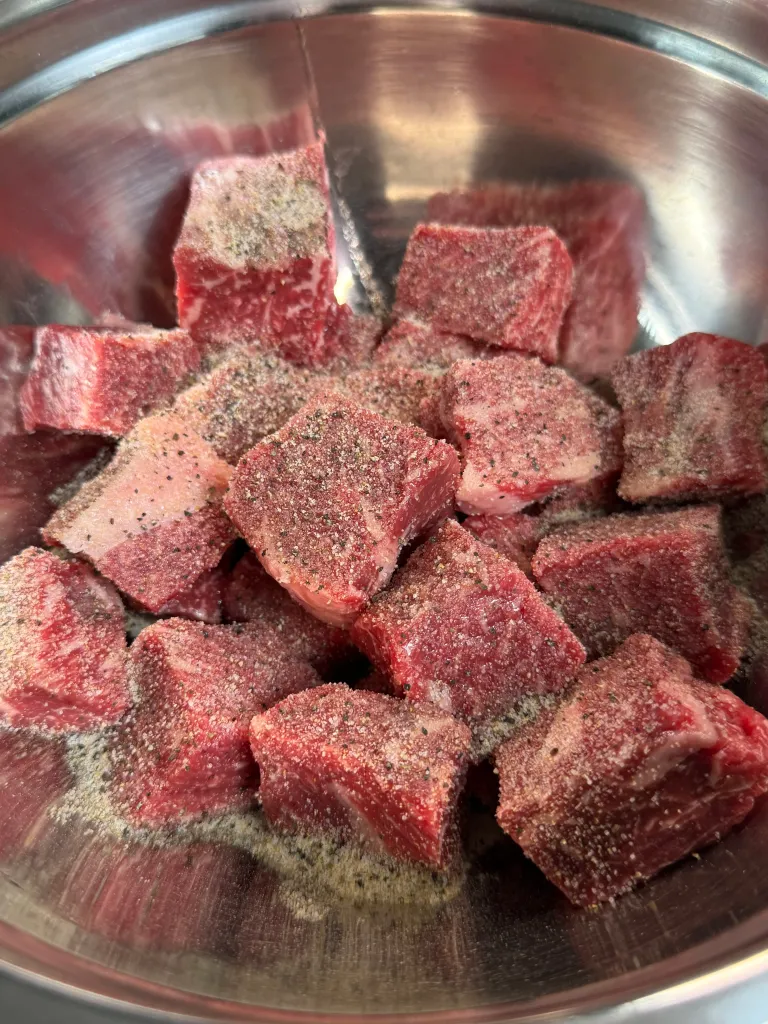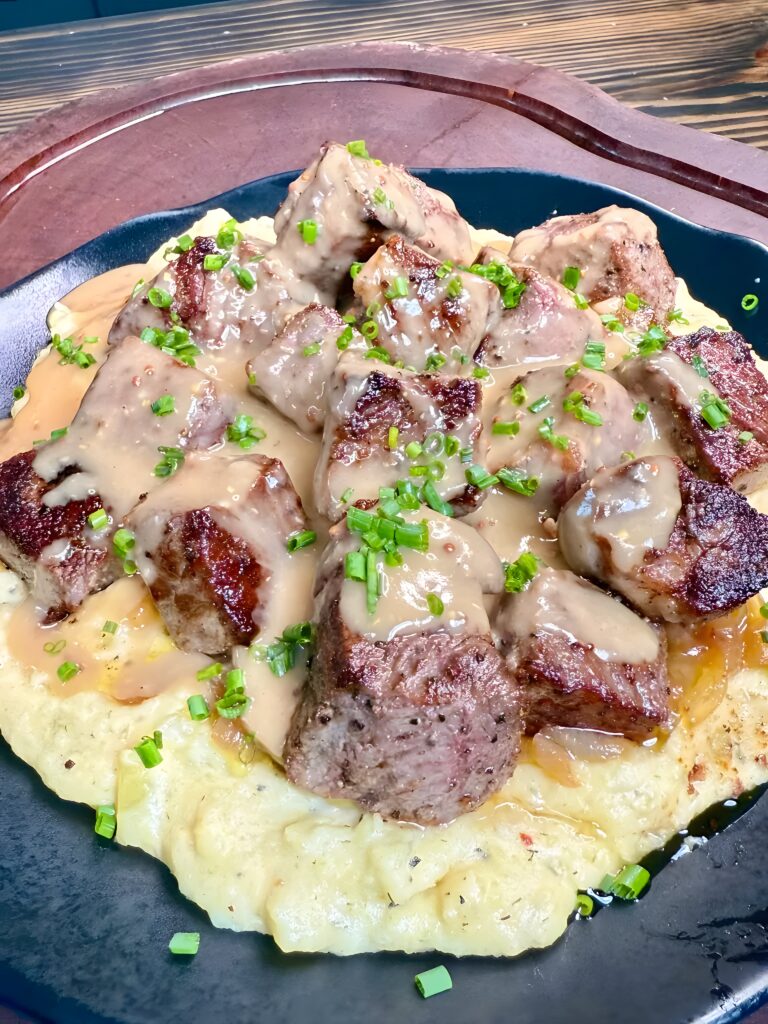Steak Bites with Mashed Potatoes and Gravy: Indulge in perfectly seared, tender steak bites paired with velvety mashed potatoes and rich, savory gravy in this comprehensive comfort food recipe. Learn professional techniques for achieving restaurant-quality results at home, complete with ingredient selection tips, cooking methods, and flavor variations. This complete guide covers everything from choosing the right cut of beef to creating the perfect gravy consistency, making it ideal for both weeknight dinners and special occasions.
Introduction
Few dishes capture the essence of comfort food quite like tender, juicy steak bites served alongside creamy mashed potatoes and rich, flavorful gravy. This classic combination represents the perfect marriage of textures and flavors that has been satisfying appetites for generations. What makes this dish particularly appealing is its ability to deliver restaurant-quality satisfaction in the comfort of your own home, while remaining accessible enough for weeknight preparation.
The beauty of steak bites lies in their versatility and quick cooking time. Unlike traditional steaks that require precise timing and temperature control, bite-sized pieces of beef cook rapidly and evenly, making them nearly foolproof while still delivering that coveted steakhouse experience. When paired with perfectly smooth mashed potatoes and a well-crafted gravy, the result is a meal that feels both elegant and deeply satisfying.
This comprehensive guide will walk you through every aspect of creating this beloved dish, from selecting the ideal cut of beef to achieving the perfect gravy consistency. We’ll explore professional techniques, common pitfalls to avoid, and variations that can transform this classic into your own signature dish.
Mashed Potatoes and Brown Gravy Recipe | How to make Brown Gravy
Detailed Ingredients
For the Premium Steak Bites:
- 2 lbs top sirloin or ribeye steak, cut into 1-inch uniform cubes (choose well-marbled cuts for maximum tenderness)
- 3 tablespoons high-heat cooking oil (avocado oil or grapeseed oil preferred)
- 4 tablespoons unsalted butter (European-style for richer flavor)
- 4 large garlic cloves, finely minced
- 1½ teaspoons kosher salt (Diamond Crystal preferred)
- ¾ teaspoon freshly ground black pepper
- ½ teaspoon sweet paprika
- ¼ teaspoon garlic powder
- ¼ teaspoon onion powder
- 2-3 fresh thyme sprigs (or 1 teaspoon dried thyme)
- 1 tablespoon fresh rosemary, finely chopped (optional)
- 1 teaspoon Worcestershire sauce (for finishing)
For the Luxurious Mashed Potatoes:
- 3 lbs Yukon Gold potatoes, peeled and cut into evenly-sized 2-inch chunks
- ¾ cup whole milk, warmed to room temperature
- 6 tablespoons unsalted butter, room temperature
- ¼ cup heavy cream (for extra richness)
- 3 tablespoons sour cream (adds tanginess and creaminess)
- 1½ teaspoons kosher salt (adjust to taste)
- ¼ teaspoon white pepper (maintains color while adding heat)
- 2 tablespoons fresh chives, finely chopped (for garnish)
- 1 tablespoon roasted garlic paste (optional, for depth)
For the Rich, Savory Gravy:
- 4 tablespoons unsalted butter
- ¼ cup all-purpose flour
- 2½ cups high-quality beef broth (low-sodium preferred)
- ½ cup heavy cream
- 2 tablespoons red wine (optional, for complexity)
- 1 tablespoon Worcestershire sauce
- 1 teaspoon onion powder
- ½ teaspoon garlic powder
- ¼ teaspoon dried thyme
- 2 tablespoons pan drippings (reserved from cooking steak)
- Salt and freshly ground black pepper to taste
- 1 teaspoon beef base or bouillon paste (for extra richness)
Additional Garnishes and Accompaniments:
Warm dinner rolls or crusty bread
Fresh parsley, chopped
Flaky sea salt for finishing
Freshly cracked black pepper
Butter pats for serving

Comprehensive Cooking Instructions
Phase 1: Preparing the Perfect Mashed Potatoes (30 minutes)
The foundation of any great comfort meal starts with properly prepared mashed potatoes. The key to achieving restaurant-quality results lies in selecting the right variety of potato and employing proper technique throughout the cooking process.
Step 1: Potato Selection and Preparation Begin by selecting high-quality Yukon Gold potatoes, which offer the ideal balance of starch and moisture content for creamy mashed potatoes. Avoid russet potatoes for this application, as they tend to become gluey when overworked. Peel the potatoes using a sharp vegetable peeler, removing any eyes or blemishes. Cut the potatoes into uniform 2-inch chunks to ensure even cooking. Uniformity is crucial for achieving consistent texture throughout.
Step 2: The Cooking Process Place the cut potatoes in a large, heavy-bottomed pot and cover completely with cold, salted water. The water should be seasoned generously with salt, approximately 1 tablespoon per quart of water. Starting with cold water ensures even cooking from the outside in. Bring the water to a rolling boil over high heat, then reduce to a steady simmer. Cook for 18-22 minutes, or until the potatoes are completely tender when pierced with a fork. The potatoes should offer no resistance when tested.
Step 3: Draining and Drying Drain the potatoes thoroughly in a large colander, shaking gently to remove excess moisture. Return the drained potatoes to the pot and place over low heat for 1-2 minutes, stirring occasionally to evaporate any remaining surface moisture. This crucial step prevents watery mashed potatoes and ensures the proper absorption of dairy ingredients.
Step 4: Mashing Technique Remove the pot from heat and begin mashing the potatoes using a potato masher or potato ricer. For the smoothest results, a ricer is preferred, but a traditional masher will work excellently. Avoid using electric mixers or food processors, as these can overwork the potatoes and create a gluey texture. Mash until no lumps remain, working systematically across the entire batch.
Step 5: Incorporating Dairy Gradually incorporate the warmed milk, adding it slowly while continuously mashing to achieve the desired consistency. Follow with the room-temperature butter, heavy cream, and sour cream, mixing gently until fully incorporated. Season with kosher salt and white pepper, tasting and adjusting as needed. The final consistency should be creamy but able to hold its shape. Cover and keep warm while preparing the remaining components.
Phase 2: Creating the Foundation Gravy (15 minutes)
A well-executed gravy serves as the binding element that elevates this dish from good to extraordinary. The key lies in creating a proper roux and gradually building layers of flavor.
Step 1: Building the Roux In a medium, heavy-bottomed saucepan, melt the butter over medium heat until it begins to foam slightly. Add the flour all at once, whisking continuously to combine. Cook this roux for 2-3 minutes, whisking constantly to prevent burning while allowing the flour to cook out its raw taste. The mixture should have a light golden color and nutty aroma.
Step 2: Liquid Integration Begin adding the beef broth gradually, approximately ¼ cup at a time initially, whisking vigorously after each addition to prevent lumps from forming. As the mixture begins to thicken and smooth out, you can add the remaining broth more quickly. The key is patience during the initial integration to ensure a smooth, lump-free gravy.
Step 3: Seasoning and Simmering Once all the broth has been incorporated, bring the mixture to a gentle simmer. Add the Worcestershire sauce, onion powder, garlic powder, and dried thyme. Allow the gravy to simmer for 8-10 minutes, stirring occasionally, until it reaches the desired consistency. The gravy should coat the back of a spoon but still flow easily.
Step 4: Finishing Touches Stir in the heavy cream and any reserved pan drippings from the steak cooking process. If using red wine, add it now and simmer for an additional 2 minutes to cook off the alcohol. Taste and adjust seasoning with salt and pepper as needed. If the gravy becomes too thick, thin it with additional warm broth. For an ultra-smooth finish, strain the gravy through a fine-mesh sieve. Keep warm over low heat, stirring occasionally.
Phase 3: Mastering the Steak Bites (10 minutes)
The star of this dish requires careful attention to technique and timing. Properly executed steak bites should have a beautiful caramelized exterior while maintaining a tender, juicy interior.
Step 1: Steak Preparation Remove the steak from refrigeration 20-30 minutes before cooking to allow it to come to room temperature. This ensures even cooking throughout. Using a sharp knife, trim any excess fat or silver skin, then cut the steak into uniform 1-inch cubes. Consistency in size is crucial for even cooking. Pat each piece completely dry with paper towels, as surface moisture is the enemy of proper searing.
Step 2: Seasoning In a large bowl, combine the kosher salt, black pepper, paprika, garlic powder, and onion powder. Add the steak cubes and toss thoroughly to coat each piece evenly. Allow the seasoned meat to rest for 5-10 minutes, which allows the salt to begin drawing out moisture that will then be reabsorbed along with the seasonings.
Step 3: The Searing Process Heat a large cast-iron skillet or heavy stainless steel pan over medium-high heat until it’s smoking hot. Add the high-heat cooking oil and swirl to coat the pan evenly. Working in batches to avoid overcrowding, carefully add the seasoned steak cubes to the pan, ensuring each piece has adequate space. Overcrowding will cause the meat to steam rather than sear.
Step 4: Achieving the Perfect Sear Allow the steak bites to cook undisturbed for 2-3 minutes, developing a rich, golden-brown crust. Using tongs, rotate each piece to an adjacent side and continue cooking for another 1-2 minutes. Repeat this process until all sides have developed color. For medium-rare doneness, the total cooking time should be 6-8 minutes. Adjust timing based on your preferred level of doneness.
Step 5: Butter Basting and Aromatics In the final minute of cooking, reduce heat to medium and add the butter, minced garlic, and fresh thyme to the pan. As the butter melts and begins to foam, use a spoon to continuously baste the steak bites with the aromatic butter. This technique, borrowed from French cuisine, adds incredible flavor and helps achieve a glossy, restaurant-quality finish.
Step 6: Resting and Finishing Remove the steak bites from the heat and transfer to a warm plate. Drizzle with any remaining pan butter and a splash of Worcestershire sauce. Allow the meat to rest for 2-3 minutes, which allows the juices to redistribute throughout each piece. Reserve any remaining pan drippings for the gravy.
Phase 4: Assembly and Presentation
The final presentation of this dish is crucial for creating that restaurant-quality experience at home.
Step 1: Plating Strategy Use warmed dinner plates for optimal presentation and to keep the food at proper serving temperature. Create a generous bed of mashed potatoes on each plate using a large spoon or ice cream scoop, then use the back of the spoon to create a shallow well in the center.
Step 2: Strategic Placement Arrange the steak bites attractively over and around the mashed potatoes, ensuring each portion receives an equal distribution of meat. The contrast between the golden-brown steak and the creamy white potatoes creates visual appeal.
Step 3: Gravy Application Ladle the warm gravy generously over the steak bites and mashed potatoes, allowing it to pool in the well you created. The gravy should coat the components without overwhelming them.
Step 4: Final Garnishes Finish each plate with a sprinkle of fresh chives, chopped parsley, or a combination of both. A light dusting of freshly cracked black pepper and a small pat of butter on the mashed potatoes adds the perfect finishing touch.
Professional Tips and Techniques
Temperature Control: Use an instant-read thermometer to ensure your steak bites reach your preferred doneness. For medium-rare, aim for an internal temperature of 130-135°F.
Pan Selection: Cast iron retains and distributes heat evenly, making it ideal for searing. If using stainless steel, ensure it’s fully preheated before adding oil.
Batch Cooking: Never overcrowd your pan. Cook steak bites in batches if necessary to maintain proper searing temperature.
Gravy Consistency: A proper gravy should coat the back of a spoon but still flow easily. If it’s too thick, whisk in warm broth gradually until desired consistency is reached.
Storage and Reheating
Leftover components can be stored separately in the refrigerator for up to 3 days. Reheat mashed potatoes gently with a splash of milk or cream. Steak bites are best reheated quickly in a hot skillet to maintain their texture. Gravy can be reheated slowly, whisking in additional liquid if needed to restore proper consistency.
This comprehensive approach to Steak Bites with Mashed Potatoes and Gravy ensures that every element works in harmony to create a memorable dining experience that rivals any steakhouse while providing the comfort and satisfaction of a home-cooked meal.

FAQs:
What kind of steak is best for steak bites?
Garlic Butter Steak Bites Recipe Ingredients:
Steak – When it comes to the best tender cuts of beef for this recipe, New York Strip Steak works great. I would not recommend tri-tip steak or beef stew meat unless you want to do a marinade. Filet mignon or ribeye steak are some other good steak options.
What goes well with mashed potatoes and gravy?
Mashed potatoes are a staple side dish in American cuisine. They are commonly paired with dishes like roast turkey during Thanksgiving, fried chicken, meatloaf, steak, and pork chops. They’re also frequently accompanied by gravy, especially during holiday meals.
What does Gordon Ramsay put in his mashed potatoes?
Gordon Ramsay’s mashed potatoes are known for their richness and flavor. He typically adds butter, heavy cream, and sometimes crème fraîche to his mashed potatoes for a creamy and indulgent texture. Additionally, he often incorporates roasted garlic or chives for extra flavor.
How to cook steak pieces in gravy?
Pour the beef broth into the pot and whisk the mixture well. Then, add the soy sauce, Worcestershire, thyme, bay leaf, and seared beef. Cook: Bring the mixture to a boil then reduce the heat to a simmer. Let it simmer for 30 minutes, or until the gravy has thickened and the beef is tender.
What seasoning is good for steak bites?
Not seasoning the steak: Seasoning the steak bites with salt, pepper, and garlic powder is essential for adding flavor. Don’t skimp on the seasoning; it makes a significant difference in the taste. Not using enough garlic: Always opt for fresh garlic to enhance the taste of your garlic butter steak bites.
What is the best mixer for mashed potatoes?
The KitchenAid® stand mixer makes quick, easy work of homemade mashed potatoes. Achieve your ideal texture with less effort and add mix-ins quickly and consistently.
What is in KFC mashed potatoes?
According to KFC’s website, their mashed potatoes include potatoes, whey product, salt, and some difficult-to-pronounce ingredients, natural flavors and natural colors. You’d have a hard time replicating those ingredients in a home kitchen

Enjoy this deliciously comforting Steak Bites with Mashed Potatoes and Gravy, packed with flavor and perfect for any occasion!


